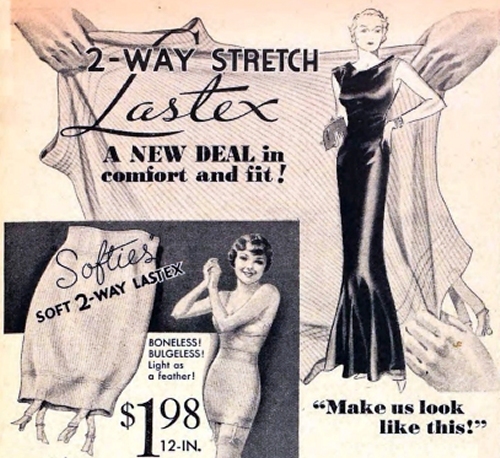
“Make us look like this!” Sears catalog, Spring 1934, featuring Lastex two-way stretch girdles: “Boneless! Bulgeless!”
Many changes in fashion were taking place between 1929 and 1934, in addition to the fall of the hemline and the rise of the waistline.
For the first time in centuries, fashions followed the natural shape of a woman’s body. Bias-cut dresses, which clung to every curve, were already chic in 1929.
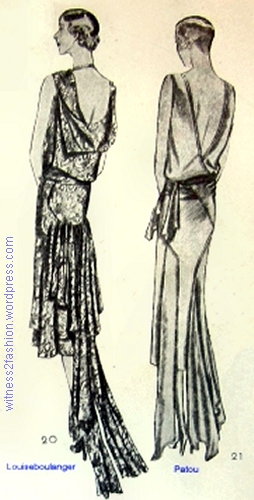
November, 1929. Form fitting gowns from French designers Louiseboulanger and Jean Patou. The Delineator.
Makers of bosom-flattening brassieres — such as the “Flatter-U” and “Boyshform” bandeaux — were losing younger customers to companies like “Maiden Form” and G.M. Poix’s “A-P Uplift.” The word “uplift” was applied rather freely.
Farrell-Beck and Gau, authors of the book Uplift: The Bra in America, point out that in previous centuries, corsets pushed the breasts up from below; now, brassieres with shoulder straps lifted the breasts up.
After the mono-bosom years earlier in the 20th century, the word “uplift” seems to include the idea of separation. Women were finally acknowledged to have two breasts, one on either side of the sternum.
The garment that had been called a “corset” (or “corselette,” if it was unboned) became a “foundation.”
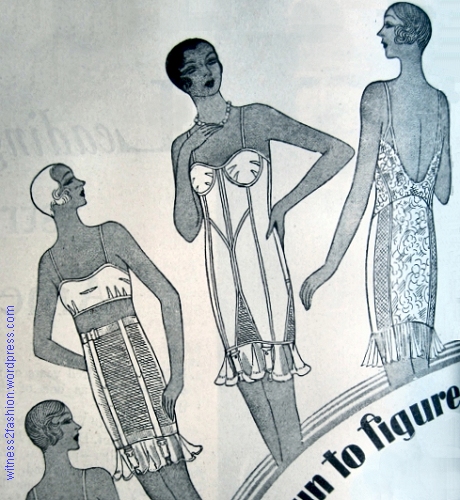
This illustration of the latest foundation garments appeared in The Delineator as early as March, 1929.
“Out went the whalebone. In went elastic. . . . The ‘foundation garment’ or ‘costume foundation’ . . . has definitely supplanted the word ‘corset’ and earned universal approval.” — Editorial in The Delineator, March 1929.
Several months later, this article appeared, with illustrations more typical of 1929 undergarments:

“Facts and Figures about the strikingly feminine new silhouette.” Article in The Delineator, October 1929.
“Gone are the days of the straight-line, belted-about-the-hips frock which concealed many of our figure deficiencies. Snug fitting hips, slightly raised and occasionally nipped-in waists, a frank recognition of the bust line, are characteristic of autumn styles.” — Lucile Babcock, in The Delineator, Oct. 1929.
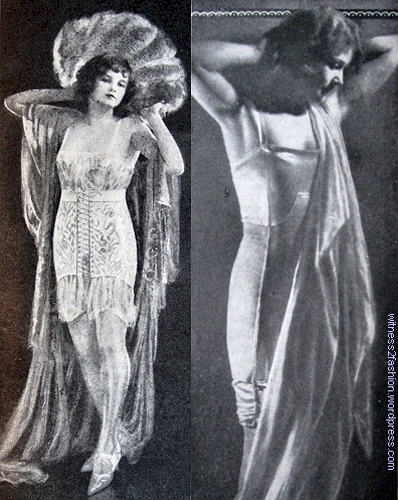
Before the change: two mid-twenties’ corsets. Left, a La Camille corset ad, 1924, and right, a Bien Jolie corset ad, 1925. Both from The Delineator.
The corset went through other changes after 1929.
Bias-cut satin dresses like these would have revealed every bump, boning channel, and lacing of an old-fashioned corset.
In 1929, the Sears catalog shows “boyish”/bust-suppressing corsets on the same page as corsets with soft, non-flattening tops. 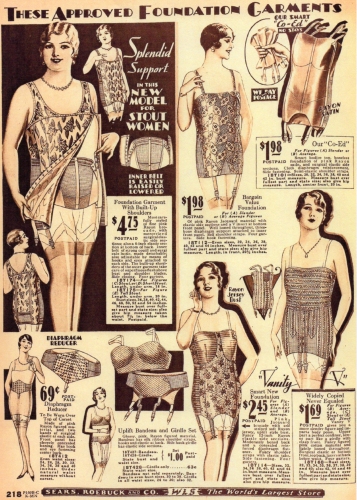
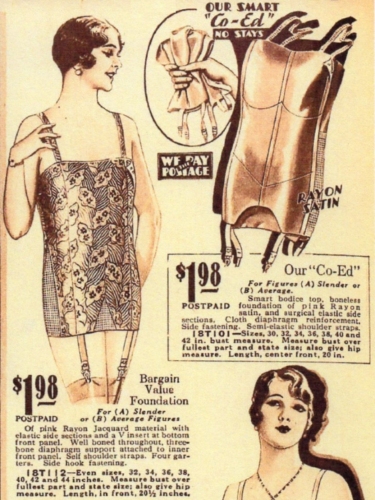
The foundation on the left is a typical 1920’s corset; bust-flattening boned seams and no waist indentation turn the body into a tube shape.
Significantly, the 1929 corset on the left below has rayon jersey (knit) in the bust area. Although not truly cup shaped, the soft fabric was not designed to flatten the breasts, unlike the boned garment on the right.
Several of Sears’ 1929 corsets/foundations use soft rayon jersey over the bust.
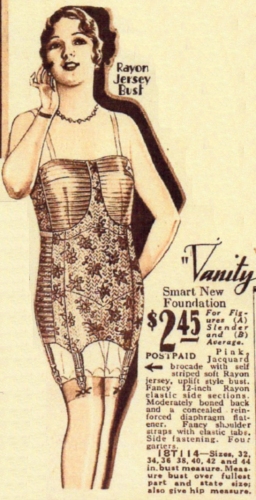
Foundation with “uplift style” rayon bust; Fall 1929 Sears catalog, p. 218. It’s hard to believe that this did much “lifting.”
But the chief problem of late 1920’s corsets (or foundations, as they were now being called) was that their stretch panels had to be made from something like surgical elastic (similar to the Ace bandages used for sprained wrists and ankles.) At the time, elasticized fabrics were limited in size, so the fronts and backs of corsets had to be made of traditional, non-stretch corset materials, like coutil or thick satin; they needed hook-and-eye or zipper closings, and the seams (and fastenings) were never smooth enough for wearing under thin, bias-cut gowns like this one:
Lastex Changes Corsetry
The revolution came in the early 1930’s, when a new method for processing rubber was invented. According to Elizabeth Ewing’s Fashion in Underwear, before 1930 the sap of rubber trees (latex) was dried and compressed into bricks for shipping. When it reached England, the bricks were liquified, and long sheets of rubber were made. These sheets would then be cut into strips and incorporated into fabrics, but the strips were never long enough to be effectively woven into material suitable for the mass production of corsets.
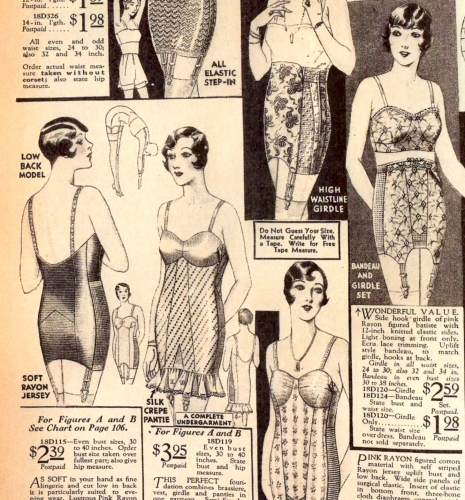
Fall 1930 Sears catalog. Before the invention of Lastex, elastic panels had to be used sparingly or pieced together. (However, by 1930 the bust is definitely back in style.)
“About 1930,” a new chemical process allowed latex to be shipped in its liquid form. The liquid latex could then be extruded into fine threads — called Lastex — which were as long as threads of traditional materials, which meant that elasticized yardage could finally be made in lengths and widths suitable for mass produced garments. As soon as weaving and knitting machines had been adapted to use Lastex, a new kind of undergarment became possible.
My question was, “How much time did it take for undergarments made with Lastex to become available — and affordable — to working class women?”
The answer: Hardly any time at all! The Sears, Roebuck catalog for Spring 1932 proudly introduces Lastex and “Clingtex” garments made of “new, cloth-like elastic (Lastex.)”
Early Lastex foundations combined the new stretch fabric with traditional corset materials — for extra control over the abdomen, for example.
By Fall of 1933, however, Sears was offering “Two-Way Stretch Softies” made entirely of stretch fabric. The “roll-on” girdle, which required no fastenings, “dates from 1932 in England and probably a year earlier in the U.S.A.” [Ewing]
These “step-in” stretch foundations, which pull on, were made on a circular knitting machine; not only did they have no zippers , they had no seams.
A foundation garment that made a woman look firmer, smoother, and younger — which improved her natural figure without distortion — was perfect under the bias gowns of the 1930s. This 1933 “Softie” All-in One from Sears (on the left) )looks very much like the Spandex “smoothers” available in stores in 2015.
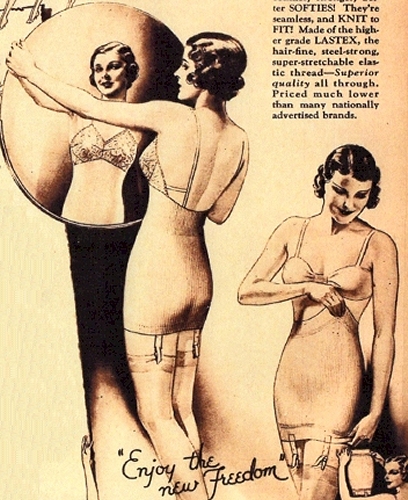
A seamless, Lastex knit foundation garment, Sears, Fall 1933. This foundation cost $3.69; the “roll-on” girdle (right) cost just $1.98.
Literally for the first time in hundreds of years, the purpose of a corset was not to distort a woman’s body.
The purpose of the nineteen-thirties’ foundation garment was to create the impression of a perfect, nude body under the clothes. It firmed the hips, flattened the belly, and supported the breasts, but all in imitation of nature, giving its wearer the firm, flexible figure of a healthy young woman.
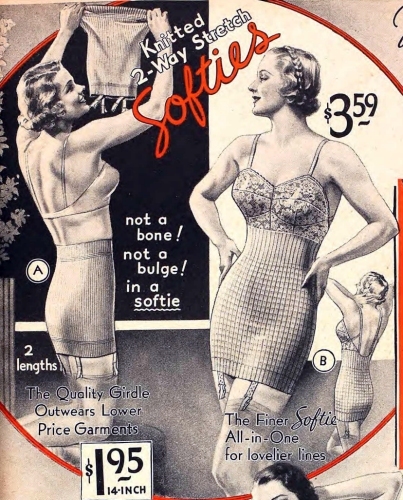
“Softies,” Fall 1934. Sears catalog. “Not a bone! Not a bulge!” Seamless, circular-knitted, two-way stretch girdle or foundation.
The End of the Boyish Figure
One more (less encouraging) thing about changes in fashion after 1929:
By Fall of 1932 women were already made to feel self-conscious about having small breasts.
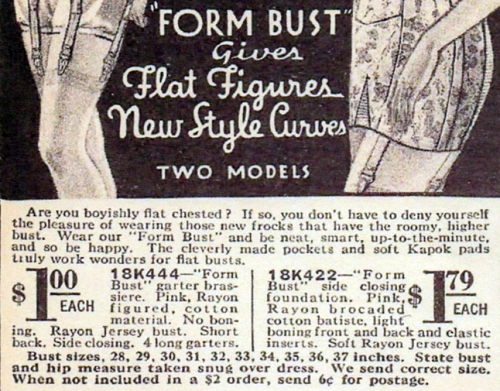
“Are you boyishly flat-chested? . . . Wear our ‘Form Bust’ and be neat, smart, up-to-the minute, and so be happy.” Sears catalog, Fall 1932.
That didn’t take long, did it?

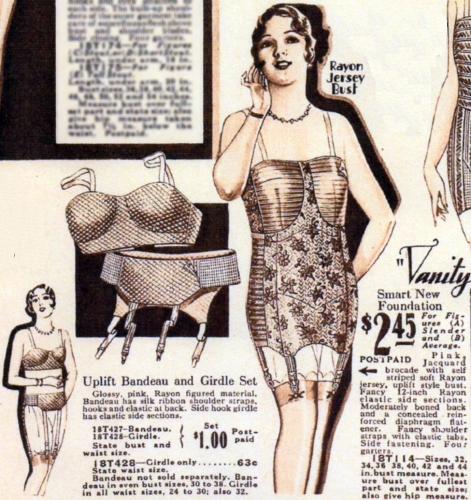

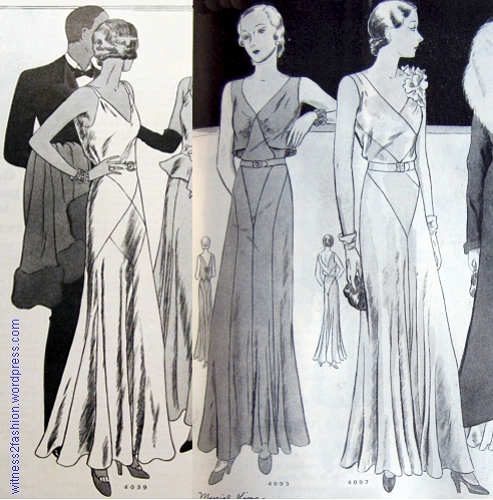
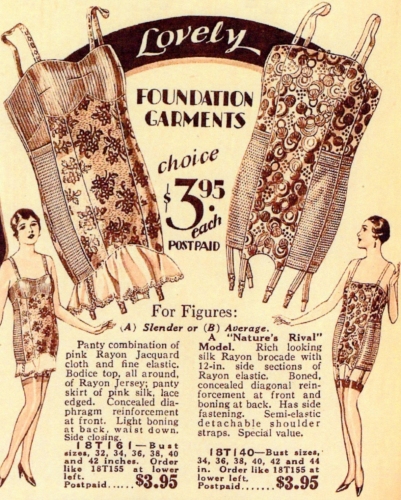
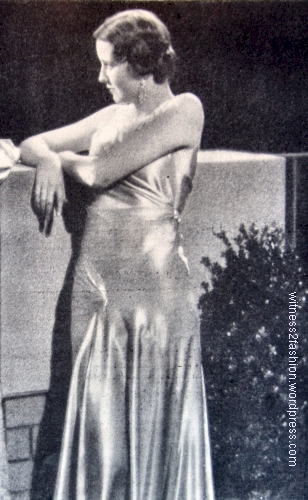
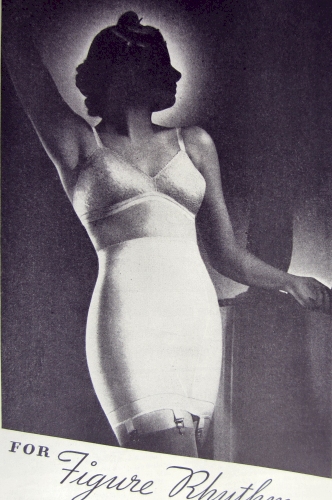
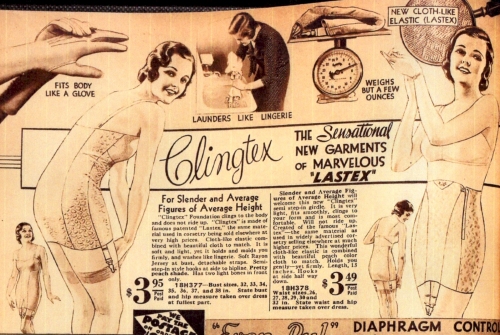
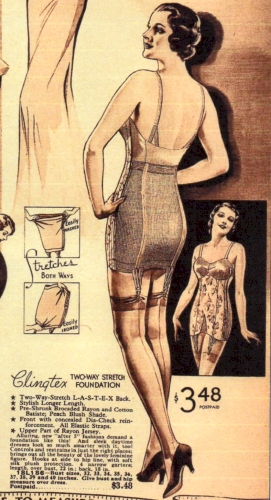
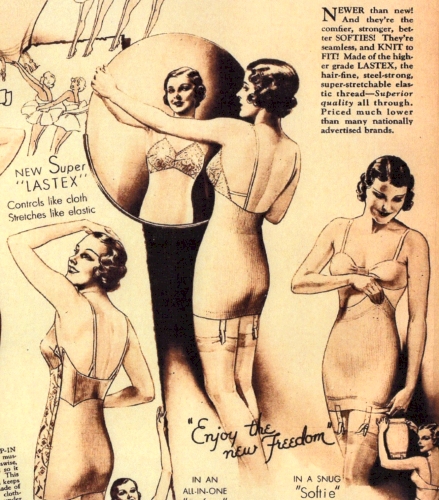
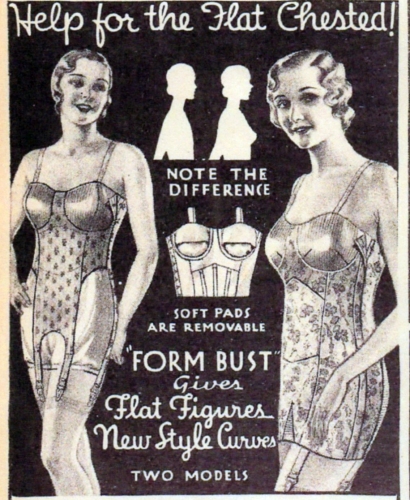
Fascinating, as always! It’s also good to be reminded that fashion shifts create winners and losers every time. Flat chested? You are a queen in the 1920s and out of luck in the 1930s. My question for you is whether or not you have ever seen a photo of an average woman in a slinky silk bias cut dress? Only movie stars come to mind for me.
You’re the woman who knows where all the archival photos are! We need some country club or society ball photos from 1930s. No one in my family photos had a shiny bias dress, but my mother did wear one in brown matelasse crepe, with matching jacket; the photo is tiny, but the outfit used to hang in our attic.. However, when I watch old movies, I watch the “dress extras” in nightclub scenes. Fred & Ginger were costumed, but often the background extras wore their own clothes. I watch women in slinky white satin and wonder, “Why don’t their garter bumps show?” Perhaps they were really nude under the dress.
“Women were finally acknowledged to have two breasts” Love it!
Thanks for the great information and terrific images. Its funny, I’m just now in the process of writing a post on foundations too, only my focus is “maternity girdles”
I have some old ads for maternity corsets, too. I’m looking forward to your post — and will link to it if I ever get around to the same topic. Sometimes I can’t be sure which Sears corsets are for maternity and which are for older women with large abdomens. The 1930’s maternity dress patterns I’ve posted seem really badly designed — with all the fullness in back. The whole subject of when women stopped hiding their pregnancy fascinates me (but I’ve never been pregnant, so what do I know?)
Pingback: Some 1930’s Evening Gowns, and What to Wear Under Them | witness2fashion
Hello…thank you for ANOTHER very good post.
I’m not sure that I agree with you when you say
….quote “The purpose of the nineteen-thirties’ foundation garment was to create the impression of a perfect, nude body under the clothes. ”
Both the corsets and girdles of this were quite “strong” by today’s standards. Certainly it was not acceptable to be seen without some form of control. Not only for shape but also that even the light 1930 girdles changed posture, movement etc. While many young women adopted these lighter garments, there were many who still wore the older style, well boned with busk and sometimes underbelt.
I’ve seen a comment somewhere from the 1930s saying that unboned girdles should not be worn all the time as they were dangerous to the figure which needed something firmer and more supportive.
Also, my mother was in the Women’s Air Force (UK) during WW2. She told me that during a pep talk given to recruits who had just completed their basic training. The 50? year old female senior officer/dragon told the recruits that “we are asked to do a man’s job in this war, it’s important that we are well corsetted to have the support necessary to do this”. A corset was standard issue as uniform, and you could ask for a stronger version “if necessary”!
Now this dragon would have been born in the 1890s and would have grown up in the 1900s when corsets were still morally, physically, intellectually necessary, let alone required for fashion.
D
Thanks for that great story about “military life.” You’re right that most women wore more traditionally supportive undergarments in the early 30s — partly because the “Softies” and “Flexees” couldn’t do much with a figure that was not pretty youthful (and slim or average) to begin with. My own grandmother wore a fully boned lace up corset till she died, in the 1950s. Also, bra cup sizes were not yet considered (or standard in bras, either,) so older women who were not very slim kept wearing older styles. They could choose less revealing evening dresses, too — and matte fabrics. I have lots of ads for Spencer and Charis corsets — more expensive and much more traditional.
So fascinating, and an excellent illustration of how styles overlap and merge.
Pingback: Permanents and Marcels Bridge the Twenties to Thirties | witness2fashion
Pingback: The Letty Lynton Dress, Adrian, and Joan Crawford’s Shoulders: Part 1. | witness2fashion
Pingback: Bad History, and a Bit about Lastex | The Vintage Traveler
Pingback: Modart Corset Ad, March 1928 | witness2fashion
Pingback: Lux for Laundry Ads 1930s | witness2fashion
Pingback: More “WTFashion?” Ads from Delineator: Bust Confiners (1900s) to Brassieres (1920s) | witness2fashion
Pingback: From Curved to Straight and Back Again: Corsets 1917 to 1929 | witness2fashion
Pingback: Sensual suits and strong skirts: opinions on masculine female fashion in interwar time and feminine male fashion today. – The Experience of Modernity
Pingback: 1953 – Lastex US Rubber – Mid-Century Page